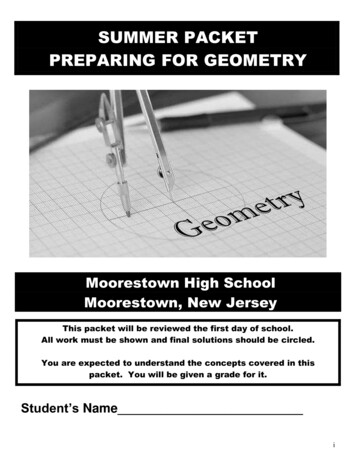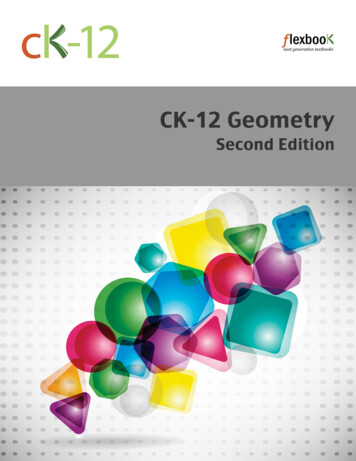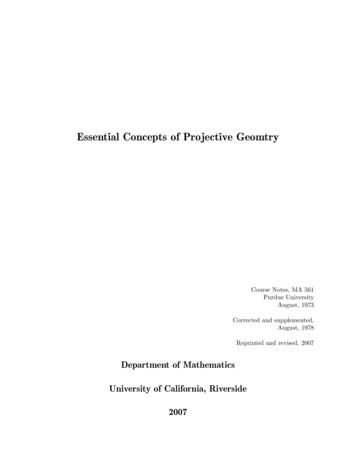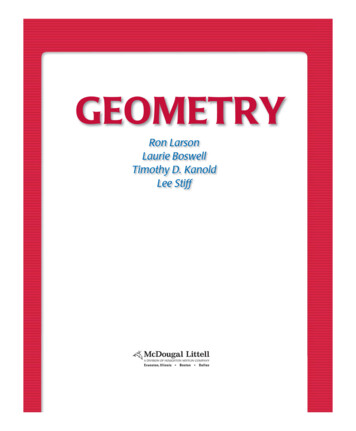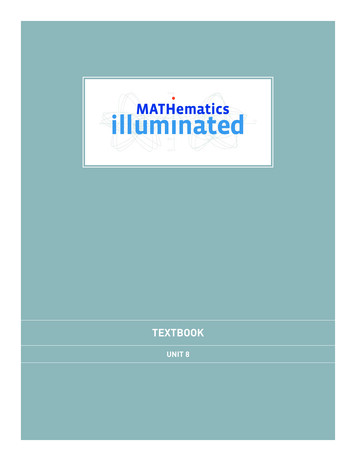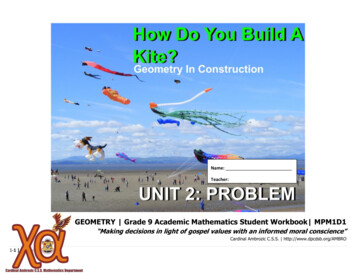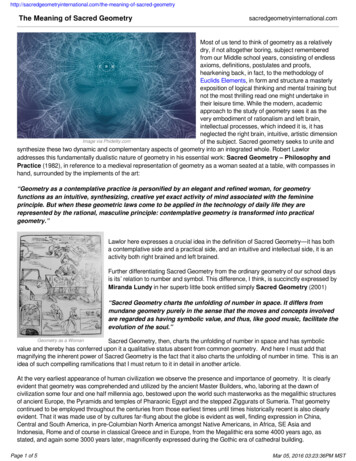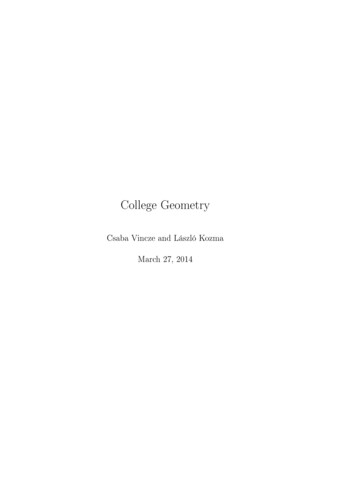
Transcription
College GeometryCsaba Vincze and László KozmaMarch 27, 2014
2
ContentsIntroductionI9Elementary Geometry111 General computational skills1.11.21.313Numbers . . . . . . . . . . . . . . . . . . . . . . . . . . . . . .131.1.1Natural numbers. . . . . . . . . . . . . . . . . . . . .131.1.2Integers. . . . . . . . . . . . . . . . . . . . . . . . . .141.1.3Rationals. . . . . . . . . . . . . . . . . . . . . . . . .151.1.4Exercises . . . . . . . . . . . . . . . . . . . . . . . . . .151.1.5Irrational numbers161.1.6Complex numbers/vectors. . . . . . . . . . . . . . . . . . . . . . . . . . . . . . . . . . .16Exercises . . . . . . . . . . . . . . . . . . . . . . . . . . . . . .16Limits21. . . . . . . . . . . . . . . . . . . . . . . . . . . . . . .1.3.1Approximation of irrational numbers. . . . . . . . . .211.3.2The problem of the shortest way . . . . . . . . . . . . .241.3.3The area of the unit circle. . . . . . . . . . . . . . . .251.4Exercises . . . . . . . . . . . . . . . . . . . . . . . . . . . . . .261.5Functions31. . . . . . . . . . . . . . . . . . . . . . . . . . . . .1.5.1Exponentials1.5.2Trigonometric functions. . . . . . . . . . . . . . . . . . . . . . . . . . . . . . . . . . . . . . .32311.5.3Polynomials . . . . . . . . . . . . . . . . . . . . . . . .321.6Exercises . . . . . . . . . . . . . . . . . . . . . . . . . . . . . .331.7Means. . . . . . . . . . . . . . . . . . . . . . . . . . . . . . .411.8Exercises . . . . . . . . . . . . . . . . . . . . . . . . . . . . . .431.9Equations, system of equations. . . . . . . . . . . . . . . . .441.10 Exercises . . . . . . . . . . . . . . . . . . . . . . . . . . . . . .452 Exercises2.147Exercises . . . . . . . . . . . . . . . . . . . . . . . . . . . . . .347
4CONTENTS3 Basic facts in geometry573.1The axioms of incidence. . . . . . . . . . . . . . . . . . . . .573.2Parallelism . . . . . . . . . . . . . . . . . . . . . . . . . . . . .583.3Measurement axioms . . . . . . . . . . . . . . . . . . . . . . .593.4Congruence axiom603.5Area. . . . . . . . . . . . . . . . . . . . . . . . . . . . . . . .613.6Basic facts in geometry . . . . . . . . . . . . . . . . . . . . . .613.6.1Triangle inequalities623.6.2How to compare triangles I - congruence. . . . . . . .623.6.3Characterization of parallelism . . . . . . . . . . . . . .643.6.4How to compare triangles II - similarity . . . . . . . . .65. . . . . . . . . . . . . . . . . . . . . . . . . . . . . . . . . . . . . . . . . .4 Triangles694.1General triangles I. . . . . . . . . . . . . . . . . . . . . . . .694.2The Euler line and the Feuerbach circle . . . . . . . . . . . . .714.3Special triangles . . . . . . . . . . . . . . . . . . . . . . . . . .744.4Exercises . . . . . . . . . . . . . . . . . . . . . . . . . . . . . .774.5Trigonometry. . . . . . . . . . . . . . . . . . . . . . . . . . .794.6Exercises . . . . . . . . . . . . . . . . . . . . . . . . . . . . . .844.7General triangles II - Sine and Cosine rule. . . . . . . . . . .864.7.1Sine rule . . . . . . . . . . . . . . . . . . . . . . . . . .864.7.2Cosine rule874.7.3Area of triangles4.8. . . . . . . . . . . . . . . . . . . . . . . . . . . . . . . . . . . . . . . . . . . .88Exercises . . . . . . . . . . . . . . . . . . . . . . . . . . . . . .905 Exercises5.193Exercises . . . . . . . . . . . . . . . . . . . . . . . . . . . . . .6 Classical problems I931016.1The problem of the tunnel . . . . . . . . . . . . . . . . . . . . 1016.2How to measure an unreachable distance . . . . . . . . . . . . 1026.3How far away is the Moon. . . . . . . . . . . . . . . . . . . . 1037 Quadrilaterals1077.1General observations. . . . . . . . . . . . . . . . . . . . . . . 1077.2Parallelograms . . . . . . . . . . . . . . . . . . . . . . . . . . . 1087.3Special classes of quadrilaterals. . . . . . . . . . . . . . . . . 1107.3.1Symmetries. . . . . . . . . . . . . . . . . . . . . . . . 1117.3.2Area . . . . . . . . . . . . . . . . . . . . . . . . . . . . 112
CONTENTS58 Exercises8.1115Exercises . . . . . . . . . . . . . . . . . . . . . . . . . . . . . . 1159 Polygons9.1125Polygons . . . . . . . . . . . . . . . . . . . . . . . . . . . . . . 12510 Circles12710.1 Tangent lines. . . . . . . . . . . . . . . . . . . . . . . . . . . 12710.2 Tangential and cyclic quadrilaterals . . . . . . . . . . . . . . . 13110.3 The area of circles. . . . . . . . . . . . . . . . . . . . . . . . 13211 Exercises13511.1 Exercises . . . . . . . . . . . . . . . . . . . . . . . . . . . . . . 13512 Geometric transformations12.1 Isometries12.2 Similarities145. . . . . . . . . . . . . . . . . . . . . . . . . . . . . 145. . . . . . . . . . . . . . . . . . . . . . . . . . . . 14813 Classical problems II15113.1 The problem of the bridge. . . . . . . . . . . . . . . . . . . . 15113.2 The problem of the camel. . . . . . . . . . . . . . . . . . . . 15213.3 The Fermat point of a triangle . . . . . . . . . . . . . . . . . . 15214 Longitudes and latitudesII155Analytical Geometry15 Cartesian Coordinates in a Plane15.1 Coordinates in a plane159161. . . . . . . . . . . . . . . . . . . . . . 16115.2 Exercises . . . . . . . . . . . . . . . . . . . . . . . . . . . . . . 16515.3 The distance between points . . . . . . . . . . . . . . . . . . . 16615.4 Exercises . . . . . . . . . . . . . . . . . . . . . . . . . . . . . . 16815.5 Dividing a line segment in a given ratio . . . . . . . . . . . . . 16915.6 Exercises . . . . . . . . . . . . . . . . . . . . . . . . . . . . . . 17115.7 The equation of a circle . . . . . . . . . . . . . . . . . . . . . . 17215.8 Exercises . . . . . . . . . . . . . . . . . . . . . . . . . . . . . . 17415.9 The equation of a curve represented by parameters. . . . . . 17515.10Exercises . . . . . . . . . . . . . . . . . . . . . . . . . . . . . . 177
6CONTENTS16 The Straight Line17916.1 The general equation of a straight line. . . . . . . . . . . . . 17916.2 Particular cases of the equation of a line. . . . . . . . . . . . 18116.3 Exercises . . . . . . . . . . . . . . . . . . . . . . . . . . . . . . 18316.4 The angle between two straight lines. . . . . . . . . . . . . . 18416.5 Exercises . . . . . . . . . . . . . . . . . . . . . . . . . . . . . . 18616.6 The parallelism and perpendicularity of lines . . . . . . . . . . 18716.7 Exercises . . . . . . . . . . . . . . . . . . . . . . . . . . . . . . 18916.8 Basic problems on the straight line. . . . . . . . . . . . . . . 18916.9 Exercises . . . . . . . . . . . . . . . . . . . . . . . . . . . . . . 19217 Vectors19317.1 Addition and subtraction of vectors . . . . . . . . . . . . . . . 19317.2 Exercises . . . . . . . . . . . . . . . . . . . . . . . . . . . . . . 19517.3 Multiplication of a vector by a number. . . . . . . . . . . . . 19617.4 Exercises . . . . . . . . . . . . . . . . . . . . . . . . . . . . . . 19817.5 Scalar product of vectors . . . . . . . . . . . . . . . . . . . . . 19917.6 Exercises . . . . . . . . . . . . . . . . . . . . . . . . . . . . . . 20117.7 The vector product of vectors. . . . . . . . . . . . . . . . . . 20117.8 Exercises . . . . . . . . . . . . . . . . . . . . . . . . . . . . . . 20417.9 The triple product of vectors . . . . . . . . . . . . . . . . . . . 20417.10Exercises . . . . . . . . . . . . . . . . . . . . . . . . . . . . . . 20518 Rectangular Cartesian Coordinates in Space20718.1 Cartesian coordinates . . . . . . . . . . . . . . . . . . . . . . . 20718.2 Exercises . . . . . . . . . . . . . . . . . . . . . . . . . . . . . . 20918.3 Elementary problems of solid analytic geometry. . . . . . . . 20918.4 Exercises . . . . . . . . . . . . . . . . . . . . . . . . . . . . . . 21118.5 Equations of a surface and a curve in space . . . . . . . . . . . 21219 A Plane and a Straight Line19.1 The equation of a plane215. . . . . . . . . . . . . . . . . . . . . 21519.2 Exercises . . . . . . . . . . . . . . . . . . . . . . . . . . . . . . 21619.3 Special positions of a plane relative to coordinate system. . . 21819.4 Exercises . . . . . . . . . . . . . . . . . . . . . . . . . . . . . . 21919.5 The normal form of the equation of a plane . . . . . . . . . . . 22019.6 Exercises . . . . . . . . . . . . . . . . . . . . . . . . . . . . . . 22119.7 Relative position of planes . . . . . . . . . . . . . . . . . . . . 22219.8 Equations of the straight line. . . . . . . . . . . . . . . . . . 22219.9 Exercises . . . . . . . . . . . . . . . . . . . . . . . . . . . . . . 22419.10Basic problems of straight lines and planes . . . . . . . . . . . 225
CONTENTS20 Acknowledgement7229
8CONTENTS
IntroductionTheory or Practice? But why or? Theory and Practice. This isthe Ars Mathematica.Alfréd RényiThe word geometry means earth measurement. As far as we know theancient Egyptians were the rst people to do geometry from absolutely practical points of view. The historian Herodotus relates that in 1300 BC "if aman lost any of his land by the annual over ow of the Nile he had to reportthe loss to Pharao who would then send an overseer to measure the loss andmake a proportionate abatement of the tax" [1]. The Greeks were the rstto make progress in geometry in the sense that they made it abstract. Theyintroduced the idea of considering idealized points and lines. Using Plato'swords the objects of geometric knowledge are eternal. The Greek deductivemethod gives a kind of answer to the question how to obtain informationabout this idealized world. It was codi ed by Euclid around 300 BC in hisfamous book entitledElementsof unquestionable premisses orwhich is a system of conclusions on the basesaxioms.The method needs two fundamentalconcepts to begin working: unde ned terms such as points, lines, planes etc.and axioms (sometimes they are referred as premisses or postulates) whichare the basic assumptions about the terms of geometry.The material collected here try to t the di erent requirements comingfrom the di erent traditional points of view.One of them wants to solveproblems in practice, the other wants to develop an abstract theory independently of the empirical world. Although it is hard to realize the equilibriumof di erent requirements (lecture vs. seminar or theory vs. practice) AlfrédRényi's Ars Mathematica [2] gives us a perfect starting point: lectures andseminars, theory and practice.The rst chapter is devoted to general computational skills related tonumbers, equations, system of equations, functions etc.These tools andthe related methods are widely used in mathematics. In chapter 3 we imitate the deductive method by collecting basic facts in geometry.9Some of
10CONTENTSthem are axioms in the strict sense of the word such as the axioms of incidence, parallelism, measurement axioms and congruence axiom. We haveanother collection of facts which are not (or not necessarily) axioms. Theyare frequently used in geometric argumentations such as the parallel line intersecting theorem or the basic cases of the congruence and the similarity oftriangles. In some of these cases the proof is available later on a higher stageof the theory. Chapter 4 is devoted to the investigation of triangles whichare the fundamental gures in Euclidean geometry because quadrilaterals(chapter 7) or polygons (chapter 9) are made up of nitely many trianglesand most of not polygonal shapes like circles (chapter 10) can be imaged aslimits of polygons.Each chapter includes exercises too. Most of them have a detailed solution.Exercises in separated chapters give an overview about the previouschapter's material. The classical problems (chapter 6 and chapter 13) illustrate how to use geometry in practice. They also have a historical characterlike the problem of the tunnel (section 6.1) or how far away is the Moon(section 6.3).Figure 1: Alfréd Rényi (1921-1970).
Part IElementary Geometry11
Chapter 1General computational skills1.1NumbersNumbers are one of the most typical objects in mathematics.1.1.1Natural numbersTo develop the notion of numbers the starting point is formed by the socalled natural numbers characterized by a set of axioms due to the 19thcentury Italian mathematician Guiseppe Peano.The Peano axioms de nethe arithmetical properties of natural numbers, usually represented as a setN {(0), 1, 2, . . . , n, n 1, . . .}The Peano's axioms are formulated as follows.P1. 1 is a natural number (the set of natural numbers is non-empty).The naturals are assumed to be closed under a single-valued successor function S(n) n 1.P2. S(n) belongs toN for every natural number n.Peano's original formulation of the axioms used the symbol 1 for the " rst"natural number although axiom P1 does not involve any speci c propertiesfor the element 1. The number 2 can be de ned as 2 S(1) and so on: 3 S(2),4 S(3), . The next two axioms de ne the properties of this representation.P3. There is no any natural number satisfying S(n) 1.P4. If S(m) S(n) then m n.13
14CHAPTER 1.GENERAL COMPUTATIONAL SKILLSFigure 1.1: Graphical representation of integers.These axioms imply that the elements 1, 2 S(1), 3 S(2), .are distinctnatural numbers but we need the so-called axiom of induction to providethat this procedure gives all elements of the naturals.P5. If K is a set such that 1 is in K and for every natural number n, n is inK implies that S(n) is in K then K contains every natural number.1.1.2IntegersEquation 5 x 2 has no natural solutions. Let m and n be natural numbers.Equations of the formm x n(1.1)without solutions among naturals lead us to new quantities called integers:Z {. . . , (n 1), n, . . . , 1, 0, 1, . . . , n, n 1, . . .}.Any integer corresponds to a pair (m,n) of naturals by equation 1.1.Twoequations are called equivalent if they have exactly the same solutions. If weadd the sides of the equations m x n and n' m' x then m' n x m n' x.Thereforem0 n m n0(1.2)is a direct consequence of the formal equivalence. The pairs (m,n) and (m',n')satisfying equation 1.2 represent the same integer. In case of (5,2) this newquantity will be written as - 3.
1.1.NUMBERS1.1.315RationalsEquation 5x 2 has no
to make progress in geometry in the sense that they made it abstract. They introduced the idea of considering idealized points and lines. Using Plato's words the objects of geometric knowledge are eternal. The Greek deductive method gives a kind of answer to the question how to obtain information about this idealized world. It was codi ed by Euclid around 300 BC in his famous book entitled .


